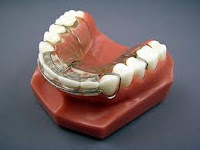If you are interested in Invisalign and live in Northern California -
This article is a definite MUST READ!!
Specialist in Orthodontics Dr. Ted Rothstein Alerts Public to Rising Levels of Substandard Invisalign Treatment by Insufficiently Trained General Dentists
PRWeb - Tue, Jul 12, 2011
An orthodontist since 1976, Dr. Rothstein, has composed a list of "due diligence" hard-hitting questions for the would-be Invisalign patient to ask the dental professional--forewarned is forearmed.
Brooklyn, NY (PRWEB) July 12, 2011
Invisalign orthodontic treatment is becoming extremely popular. General dentists are competing fiercely with the specialists in orthodontics for their share of this market. Never mind that most of them are insufficiently trained and experienced in orthodontics, and lack the temperament to provide this service. Dr. Rothstein has compiled a list of questions that every consumer can use when deciding to undergo teeth straightening.
Invisalign is a type of orthodontic treatment that can be used in place of typical "train-track" braces, depending on the severity of the bite/smile problem. Keep in mind the dentist must first accurately diagnose in detail the problem(s) of the bite condition, decide how and which teeth are to be moved then send the lab rubber impressions of the teeth to make the "aligners" with exact instructions. Finally, the dentist places "attachments" on the teeth and dispenses the aligners to the patient who must wear them 22-hours each day for 2-3 week before changing to the next aligners in the treatment series.
AlignTech created this method of treatment specifically for orthodontists, but when general dentists sued for the right to provide the service, they won the case. In 2009 Invisalign mandated that general dentist and orthodontists were henceforth required to take 10 continuing education units and submit ten cases as minimum requirements for being an Invisalign provider presumably to stem the tide of inferior treatment results. That mandate was rejected in 2010 after widespread objection from both groups (Leiszler DDS and Styger DDS v. Align Technology ,United States District Court for the Northern District of California Case No. 3:10-cv:2010-MMC)
At present a general dentist can become a provider by taking a one day eight-hour course.
Consider that there are 120,000 general dentists in the US while there are a mere 6,500 orthodontic specialists. These overwhelming odds insure that more and more consumers are choosing providers who lack sufficient training and experience to provide their patients quality results. Worse yet, the patients may never find out that the results are sub par.
Dr. Rothstein poses the key question: when preparing to embark on a once-in-a-lifetime trip that is going to take on average more than a year with as many stopovers (office visits): isn't the consumer better served by the orthodontic specialist even though having to pay a higher fee? Indeed when the consumer pays more to engage the services of the specialist isn't he receiving more in the way of experience and wisdom that far outweighs the additional fees the consumer may have to pay?
Remember the general dentist is a professional who practices "general” dentistry; this means their training and expertise lies in his ability to do a variety of dental procedures well, unlike the orthodontist who may often take as many as 15-25 office visits devoted to your one smile/bite problem, sometimes making delicate and tiny adjustments, and sometimes simply to effectuate the movement of a single tooth toward its correct position. The specialist has only one art--moving teeth. The generalist is therefore less temperamentally suited to this often tedious long drawn-out kind of bite correction.
Dr. Rothstein reports that he is seeing in recent years a growing number of patients on consultation in treatment with Invisalign by the generalist who simply lacked an understanding of the limitations of the Invisalign appliance.
General dentists are not fully trained to recognize the many nuances associated with effective treatment, or even foresee the potential problems lying in wait as they proceed. Training and experience really do make a difference.
There are also cases in mid-course where the general dentist had no idea how to handle the problem that the patient was encountering. and cases where the end result of the Invisalign treatment were so lacking that the only recourse was to finish the case with fixed braces.
Due diligence questions to ask when choosing an Invisalign provider:
Are you certified specialist in orthodontics besides being a general dentist?
Do you have an orthodontist to whom you regularly refer other cases?
Do you do the train-track braces also?
When did you begin providing Invisalign?
How many Invisalign patients do you have under treatment?
How many Invisalign patients have you completed?
Are you certain my case can be completed with Invisalign?
How many months will I be in treatment (typically two aligners/month)
Is the fee you are quoting all-inclusive?
Can you provide me with the contact information of two of your completed Invisalign patients?
Does the doctor himself personally provide my treatment?
What are some of the typical problems you have seen since you are providing Invisalign?
Dr. Rothstein's final word of advice is always seek a second opinion with a provider who is a specialist, and let them know exactly what the general dentist recommended. It's worth the additional fee (many orthodontists offer a free second opinion). Indeed, Dr. Rothstein readily maintains that when he is in a quandary related to treatment of his own patients he encourages them to obtain a second opinion.
# # #
Dr. Ted Rothstein


























